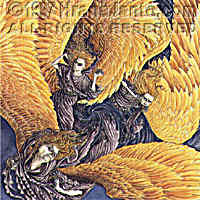 |
|
|||||
PREVIOUS | NEXT | A,B,C, D,E, F,G,H,I, J,K,L,M, N,O,P,Q, R,S, T,U,V,W,X,Y,Z | Help | ALL | INDEX
| Erinyes from Goddesses and Heroines |
Exerpt from Goddess & Heroines by Patricia
Monaghan [Used by permission. This text is NOT included in the Goddess Oracle] |
Long before the Olympians ruled the territory we now call Greece, the people there recognized three immortal black maidens with serpent hair and poisonous blood that dripped from their eyes. Clad in gray, bearing brass-studded whips, baying and barking like bitches, they roamed the pre-Hellenic world in pursuit of those who dared offend the primordial laws of kinship. They were the force that held a matriarchal world together, for these half-human women waited as punishment for anyone who dared commit the sacrilege of spilling kindred blood. The dreaded Erinyes hounded to death, like a tortured conscience, anyone who spilled such blood, painfully created by his maternal relatives, for kinship was traced through the mother.
There were three Erinyes, or there was one Erinys with three forms: Alecto ("unresting one"), Megaera ("envious anger"), and Tisiphone ("avenger"). They were born from the blood of the castrated sky god Uranus where it touched the earth mother Gaia. Standing by the throne of the sun or in the dark world of Tartarus, these implacable goddesses could be stayed by neither sacrifice nor tears once their righteous anger was aroused. Nonetheless, those hoping to avert their gaze from minor misdeeds would lay by their sanctuaries black sheep and honeyed water, white doves and narcissus flowers.
The trinity of goddesses bore many names. As the Semnae, they were worshiped as "kindly ones," although they were invariably just rather than gentle; when guilty conspirators sought their forgiveness by attaching themselves by a thread to the goddesses's statue, the Erinyes miraculously broke free, showing the Athenians that criminals deserved punishment. As the Dirae, they were "curses" personified. As Maniae or Furiae, they were the mad ones--the Furies. Most often they were called Erinyes, "the strong ones," a force so instinctive and primeval that the Greeks assured each other, "Even dogs have their Erinyes."
It was the poet Aeschylus who identified them with the helpful Eumenides, a theologically radical position, for the trinities of goddesses were originally distinct. In the famous climax to Aeschylus's Oresteia, the laws of mother right--of which the Erinyes were the fiercest symbol--are shown giving way to the newer form of social organization imported into Greece by the patriarchal Indo-Europeans. Orestes, son of Clytemnestra, killed his mother in a vengeful fury; the Erinyes hounded him until they reached the temple of Apollo, where he took sanctuary. The first trial by jury was then held, with Athena presiding; the vote was tied.
Athene cast the deciding vote, against punishment of the matricide. The Erinyes were convulsed with anger at the decision, at having a morsel stolen from their plates. "Gods of the younger generation," they screamed, "you have ridden down the laws of elder times, torn them out of my hand." They threatened to ravage the land in retaliation, but Athene consoled them with promises of sacrifices and honor. Finally, they grew reconciled to the new order and were renamed Eumenides, taking on the name and identity of a triplet of goddesses who originally had little but number in common with the Erinyes. Allowed to keep their original function, the goddesses were thereafter to exercise their calling only at the behest of the Olympian divinities.
| Back to TOP | Published by Llewellyn, copyright 1997. Used by permission of the author. |
![]()